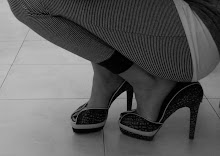During production defective shoes are often mandato avanti (sent forward on the production line) instead of being repaired because fixing a defective shoe is time consuming and expensive. When a factory has a certain number of shoes to make per day, there is no time to send a shoe back to step one to fix a defect or error. Luckily, most of these errors are easy to spot in the store before you purchase a less-than-perfect shoe. Every week I will give you tips on how to spot these imperfections.
Heel-placement can either ruin or redeem a shoe: a heel two millimeters too far forward or backward, and the shoe will not stand properly. It will not be well balanced and will feel awkward to wear. If you look at the shoe from the side, the heel should be parallel to the direction of the weight placed on the heel and sit squarely under the spot where this weight is placed.

Seen from behind, the two heels should be of the same height and should stand straight and not lean to either side. (The shoe on the right is slightly tilted outwards.)

A heel that squeaks or moves when you walk is not tightly nailed into the insole. While a squeaky heel can sometimes be fixed by a shoe repairman, it's best not to buy a shoe with any heel problems. High heels are already uncomfortable; save yourself a bit of pain and take the time to find a shoe with a properly affixed heel.
